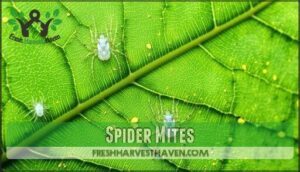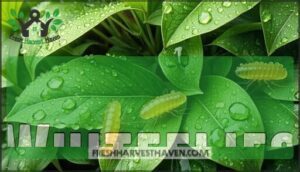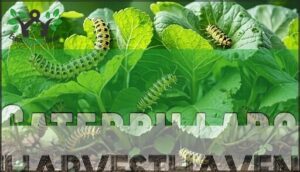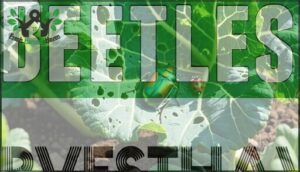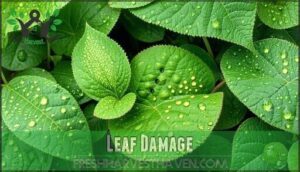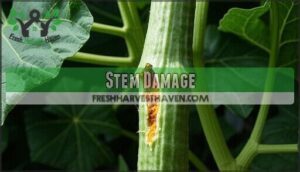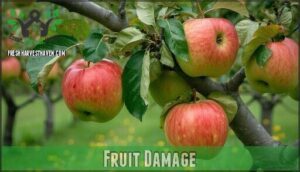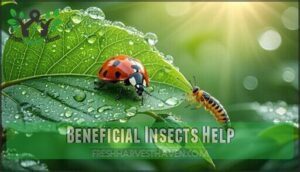This site is supported by our readers. We may earn a commission, at no cost to you, if you purchase through links.
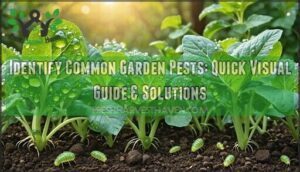 You’ll identify common garden pests faster by looking for their damage patterns than waiting to spot the insects themselves.
You’ll identify common garden pests faster by looking for their damage patterns than waiting to spot the insects themselves.
Check for aphids clustering on new growth with sticky honeydew residue, spider mites creating fine webbing on leaf undersides, whiteflies that flutter when disturbed, caterpillars leaving irregular holes in foliage, and beetles making perfectly round holes or skeletonized leaves.
Each pest leaves distinctive calling cards – from silvery stippling to curled leaves, which are crucial for timing your response.
Regular inspection of both leaf surfaces, stems, and soil around plant bases catches problems early, and knowing exactly what each clue tells you is key.
The real trick isn’t just spotting these troublemakers, but understanding the implications of their distinctive signs to take appropriate action.
Table Of Contents
- Key Takeaways
- Garden Pest Identification
- Common Garden Pests
- Pest Damage Patterns
- Beneficial Insects Help
- Pest Control Methods
- Frequently Asked Questions (FAQs)
- How do I identify pests in my garden?
- What is the most common pest in the garden?
- How do you identify what is eating my plants?
- How do I tell what animal is eating my garden?
- How do I identify my garden pest?
- Is there an app to identify garden pests?
- How do I identify common garden pests?
- What are garden pests?
- How do I identify insect pests?
- How do I know if a plant has a pest?
- Conclusion
Key Takeaways
- Check for damage patterns first – You’ll spot pests faster by looking for their calling cards, like holes, sticky honeydew, webbing, and yellowing leaves, rather than hunting for tiny insects.
- Inspect both leaf surfaces regularly – You need to examine the tops and undersides of leaves, stems, and soil around plant bases to catch problems early before they spread.
- Learn each pest’s signature damage – Aphids create sticky residue and curled leaves, spider mites leave fine webbing and stippling, while caterpillars make irregular holes in foliage.
- Use beneficial insects as natural allies – You can control pests more effectively by attracting ladybugs, parasitic wasps, and lacewings that hunt harmful insects without chemicals.
Garden Pest Identification
You’ll know your garden has unwelcome visitors when you spot the telltale signs of pest damage on your plants.
Learning to identify these common culprits by their physical features, the damage they cause, and where they prefer to hang out will help you catch problems early and keep your garden thriving.
Physical Characteristics
Spotting garden pests starts with knowing what you’re looking for. Each pest has unique physical traits that make identification easier once you know the telltale signs.
- Aphid appearance: Tiny, soft-bodied insects (1-4mm) in green, black, or white colors clustering on stems and leaves
- Caterpillar colors: Smooth or fuzzy larvae ranging from bright green to brown, often with distinctive stripes or spots
- Beetle shapes: Hard-shelled insects with oval or round bodies, from tiny flea beetles to large Japanese beetles
- Mite size: Microscopic spider-like creatures (less than 1mm) barely visible without magnification
- Larval forms: Grub-like creatures in soil or C-shaped white larvae with brown heads near roots
To aid in identification, consider damage signs and symptoms.
Damage Signs
While physical traits help you spot pests, damage patterns reveal the real story.
Look for leaf discoloration, stunted growth, and webbing signs that expose hidden invaders. Honeydew presence and frass identification provide vital clues for accurate pest identification.
| Damage Type | Visual Clues |
|---|---|
| Leaf Damage | Yellow spots, holes, stippling patterns |
| Plant Damage | Wilting, curled leaves, brown edges |
| Pest Damage | Sticky residue, silk webs, dark specks |
| Damage Patterns | Chewed stems, root exposure, fruit scars |
Location and Habitat
Understanding where garden pests prefer to hang out helps you find them before they cause major damage.
Think of it like knowing your enemy’s favorite hiding spots – it makes your pest identification much more effective.
- Soil Preference: Common garden insects like root aphids thrive in moist, well-draining soil, while grubs prefer compacted areas with poor drainage.
- Host Plants: Most garden pests target specific plants – aphids love roses and tomatoes, while squash bugs stick to cucurbit family crops.
- Regional Variations: Your local climate determines which common pests you’ll encounter – spider mites dominate hot, dry areas while slugs prefer cool, humid microclimates.
Common Garden Pests
You’ll encounter five major pest groups that can wreak havoc on your garden: aphids, spider mites, whiteflies, caterpillars, and beetles.
Each pest leaves distinct calling cards that help you identify them quickly and choose the right treatment before they turn your thriving plants into their personal buffet.
They are a significant threat to your garden’s health, and understanding their characteristics is essential for effective pest management.
Aphids
Aphids are tiny, soft-bodied garden pests that cluster on new plant growth, sucking sap and causing leaves to curl and yellow.
These tiny sap-suckers turn healthy plants into their personal juice bar, leaving curled leaves in their wake.
Their rapid aphid lifecycle leads to stunted growth in affected plants.
These prolific reproducers create sticky aphid honeydew, which attracts ants and promotes sooty mold.
Fortunately, natural predators like ladybugs effectively control populations through ant symbiosis disruption.
To combat infestations, consider using dedicated pest solutions to manage the issue.
Spider Mites
Spider mites are tiny eight-legged pests that create fine webbing on plant surfaces.
These microscopic garden pests cause stippling damage – small yellow or white spots on leaves that eventually turn bronze.
You’ll spot webbing signs on leaf undersides, especially during hot, dry conditions.
Early detection through mite identification helps prevent severe infestations.
Effective control may require specialized mite treatments to manage these destructive plant pests.
Use organic sprays like insecticidal soap or increase humidity control to manage them effectively.
Whiteflies
These tiny white flying insects cluster beneath leaves, making them easy to spot when you disturb plants.
Whiteflies cause yellowing leaves and create sticky honeydew problems that lead to black sooty mold growth.
Their feeding attracts ants, creating ant symbiosis relationships, and combat these garden pests using yellow sticky traps near affected plants and reflective mulch to confuse them.
Early pest identification prevents widespread plant damage from these persistent insect pests.
Caterpillars
If whiteflies leave you chasing tiny clouds, caterpillars bring a different storm.
For Caterpillar Identification, look for ragged holes and frass on leaves—clear signs of Defoliation Effects.
These garden pests chew through crops quickly.
Handpick them, try Bagworm Control, or use Bt Injection for tough cases.
Staying alert to insect pests helps you spot leaf damage before it gets out of hand.
Beetles
Unlike caterpillars that munch openly, beetles are armored garden pests with hard wing covers called elytra. These garden insects create irregular holes and skeletonized leaves as they feed.
You’ll spot beetle predators like birds hunting them during daylight hours. Regional beetles vary by climate, with Japanese beetles dominating eastern gardens while Colorado potato beetles target western crops.
Beetle lifecycle includes soil-dwelling larvae that damage roots. Beetle attractants include stressed plants, while beetle resistance comes from healthy soil and diverse plantings, which can also affect the overall garden ecosystem.
Pest Damage Patterns
You can identify garden pests quickly by examining the specific damage patterns they leave behind on your plants.
Different pests create distinct signs – from tiny holes and skeletonized leaves to wilted stems and scarred fruit – that act like fingerprints pointing to the culprit.
Leaf Damage
You’ll spot leaf damage patterns that tell different pest stories.
Chewed edges with irregular holes point to caterpillars munching away, while skeletonized leaves with lacy patterns scream Japanese beetles.
Stippled leaves showing tiny yellow or white dots reveal spider mites at work.
Curled leaves often mean aphids are busy sucking sap. Spotted foliage suggests various garden insects have moved in.
Each damage sign helps with pest identification, making garden pest control more targeted and effective.
Stem Damage
Borer Identification starts with spotting telltale signs around your plant stems. These sneaky pests tunnel through stems, creating entry holes and leaving behind sawdust-like frass that gives them away.
Watch for these key indicators of stem damage:
- Vine borers like squash vine borer create entry holes with moist, orange-colored frass near the base of cucurbit plants
- Tree borers including peach tree borer cause girdling effects by tunneling under bark, weakening or killing branches above the damage
- European corn borer leaves small holes in corn stalks with brown, powdery debris around entry points
Prevention Methods include removing plant debris and using row covers during peak egg-laying periods.
Root Damage
Why does your garden suddenly look like it’s dying despite perfect watering?
Root damage from garden pests often goes unnoticed until it’s too late. Hidden attackers like grubs, root weevils, and vole damage cause wilting that mimics drought stress, making pest identification tricky for gardeners.
| Pest Type | Damage Signs |
|---|---|
| Grub Infestation | Brown patches, loose turf, C-shaped larvae in soil |
| Root Aphids | Yellowing leaves, stunted growth, white cotton-like clusters |
| Nematode Damage | Galls on roots, wilting despite moisture, poor nutrient uptake |
Fruit Damage
Check your fruits regularly for telltale signs of garden pests wreaking havoc.
Fruit scars, spotted fruit, and premature drop signal insect identification problems.
Caterpillars bore into apples creating internal damage, while beetles leave surface wounds.
Rotting fruit often follows pest feeding activity.
Don’t let these sneaky invaders turn your harvest into their buffet—early plant feeding detection saves your crop.
Employing natural pest control methods can help mitigate these issues.
Beneficial Insects Help
You don’t have to fight garden pests alone—nature provides powerful allies in the form of beneficial insects that hunt down harmful pests for you.
These helpful predators can control aphids, mites, and other troublemakers more effectively than chemical sprays, creating a natural balance in your garden ecosystem.
Ladybugs
These tiny, spotted heroes are your garden’s natural pest control squad.
Ladybugs devour up to 50 aphids daily, making them powerful allies against soft-bodied pests. You’ll spot them hunting on aphid-infested plants, especially near roses and vegetables.
Attract these beneficial insects by planting dill, fennel, and yarrow.
Their complete lifecycle includes eggs, larvae, pupae, and adults—all stages help control garden pests naturally, with ladybugs being powerful allies and natural pest control.
Parasitic Wasps
These tiny warriors pack a serious punch in your garden pest identification arsenal.
Unlike their stinging cousins, parasitic wasps won’t bother you—they’re laser-focused on garden pests like aphids, whiteflies, and caterpillars.
Their wasp lifecycle involves laying eggs inside host insects, making them incredibly effective biological control agents.
You’ll attract wasps naturally with small flowers like dill and fennel.
Planting yarrow can also attract these beneficial insects.
Regional variations exist, but wasp benefits remain consistent: they’re your garden’s secret weapon against harmful insects year-round.
Green Lacewings
Green lacewing adults drift through your garden like delicate fairies, but their larvae are voracious predators.
These beneficial insects target aphids, whiteflies, and mites with impressive efficiency. The lacewing life cycle produces hungry larvae that consume hundreds of garden pests weekly.
Attract lacewings by planting daisy and dill family flowers while providing water sources. Their pest identification guide value makes them essential insect predators for natural biological control systems.
Wasps
You’ll spot beneficial wasps hovering around your garden pests like tiny bodyguards on patrol.
These natural predators hunt aphids, caterpillars, and other common garden bugs with remarkable efficiency.
Parasitic wasps lay eggs inside pest insects, while paper wasps catch caterpillars to feed their young.
Most garden wasps won’t bother you unless threatened near wasp nests.
Planting fennel and yarrow can attract more ladybugs to further help control pests, which are natural predators that help with pest control and are attracted by planting fennel.
Pest Control Methods
Once you’ve identified the garden pests damaging your plants, you’ll need effective control methods to protect your crops.
Your approach should combine multiple strategies, from gentle organic solutions to stronger interventions when necessary, using a complete approach to manage the pests.
Organic Controls
Once beneficial insects are doing their part, you can boost their efforts with gentle organic sprays.
These natural solutions target specific pests without harming helpful predators or your family’s health.
- Neem Oil coats soft-bodied insects like aphids, disrupting their life cycle while leaving beneficial insects unharmed
- Insecticidal Soap suffocates pests on contact but breaks down quickly, protecting pollinators that visit later
- Bt Application targets caterpillars specifically, leaving other insects completely untouched in your garden ecosystem
- Diatomaceous Earth creates microscopic barriers that damage crawling pests while staying safe around pets and children
Many gardeners find neem oil effective for pest control.
Physical Barriers
Beyond organic sprays, physical barriers create an invisible shield around your plants.
These garden defenses work like bouncers at a club, keeping unwanted pests out while letting beneficial insects through.
| Barrier Type | Target Pests |
|---|---|
| Row covers | Flying insects, beetles |
| Plant collars | Cutworms, root pests |
| Copper tape | Slugs, snails |
| Netting barriers | Birds, larger insects |
Fences and barricades stop deer and rabbits from munching your prized tomatoes.
These physical controls require no chemicals and work 24/7 without your supervision.
Biological Controls
Nature’s army stands ready to defend your garden.
Predator introduction works like hiring professional bodyguards for your plants. Ladybugs devour aphids while parasitic wasps target caterpillars from within.
Microbial pesticides contain beneficial bacteria that attack specific garden pests without harming beneficial insects.
Natural repellents and habitat manipulation create environments where predatory insects thrive, establishing long-term biological controls that keep pest populations balanced naturally, using biological controls.
Chemical Controls
Chemical insecticides offer quick pest knockdown when other methods fail. However, they require careful consideration of pesticide resistance, spray timing, and environmental impact.
Systemic insecticides work from within plants, while contact sprays need thorough coverage.
- Choose targeted solutions over broad-spectrum chemical sprays to protect beneficial insects
- Practice safe handling with protective equipment and follow label instructions precisely
- Consider acaricides for spider mites and rotate products to prevent resistance buildup
Frequently Asked Questions (FAQs)
How do I identify pests in my garden?
Sarah noticed tiny green bugs clustered on her tomato stems yesterday.
You’ll spot garden pests by looking for damage patterns like holes in leaves, yellowing foliage, or sticky honeydew deposits, then examining plants closely with a magnifying glass to identify garden pests.
What is the most common pest in the garden?
Aphids are probably your garden’s most frequent uninvited guests.
These tiny, soft-bodied insects cluster on new growth, sucking plant juices and leaving behind sticky honeydew that attracts ants and causes sooty mold.
How do you identify what is eating my plants?
Like a medieval detective with a magnifying glass, you’ll examine damage patterns and timing. Check for holes, sticky residue, or webbing. Look for actual pests during dawn or dusk inspections.
How do I tell what animal is eating my garden?
Look for damage patterns and timing clues.
Check for holes, bite marks, tracks, and droppings around your plants.
Notice if damage happens at night or day, since different animals feed at different times.
How do I identify my garden pest?
Don’t panic when you spot mysterious damage – you’re already ahead of many gardeners!
Look for clues like holes, sticky residue, or tiny insects, then use a magnifying glass to identify the culprit.
Is there an app to identify garden pests?
You’ll find apps like iNaturalist or PictureThis handy for snapping pest photos and getting quick IDs.
Just upload a clear image, and the app matches it with a database—no need to play garden detective alone, using apps like these can be very helpful to get quick IDs.
How do I identify common garden pests?
You’ll spot garden pests by examining damage patterns and the insects themselves. Check for chewed leaves, sticky honeydew, webbing, holes in fruit, and wilting plants despite adequate watering.
What are garden pests?
Curiously, just as weeds compete with your prized plants, garden pests are unwanted insects, animals, and creatures that damage your plants.
They do this by eating leaves, sucking sap, or attacking roots, ultimately reducing your harvest.
How do I identify insect pests?
Look for visible insects like aphids clustered on stems, check for damage patterns like chewed leaves or stippled foliage, and use tools like magnifying glasses for tiny pests.
How do I know if a plant has a pest?
Plants become silent witnesses to tiny invaders, revealing their distress through visible clues.
Check for holes in leaves, yellowing foliage, sticky honeydew, curled leaves, wilting despite watering, or small insects crawling around stems and undersides of leaves, which can indicate the presence of invaders.
Conclusion
Before smartphones made everything instant, gardeners relied on careful observation to identify common garden pests lurking in their crops.
You’ll master pest identification by combining visual clues with damage patterns rather than guessing.
Watch for aphid clusters on tender shoots, spider mite webbing underneath leaves, and caterpillar holes in foliage.
Early detection saves your plants and prevents widespread infestations.
Regular inspection becomes second nature once you know what signs to look for in your garden ecosystem.
- https://www.unifiedhomeremodeling.com/6-effective-strategies-for-managing-garden-pests/
- https://www.finegardening.com/project-guides/fruits-and-vegetables/the-best-biological-controls?srsltid=AfmBOoo2v8qJGjXMeSMfCHxQrS_cfMp5-eCVzA-_5GCIHHT5yLgYsCG_
- https://www.rhs.org.uk/prevention-protection/biological-control-garden
- https://extension.psu.edu/steps-to-controlling-insect-pests-in-the-garden


